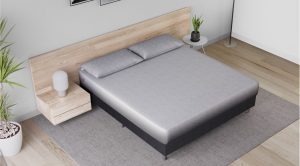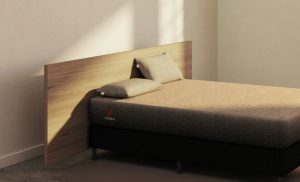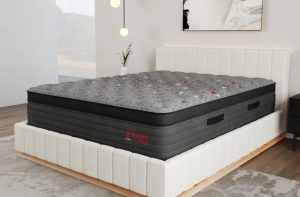Best Mattress for a Herniated Disc
Herniated disc pain is often at its worst in the morning because your body has been inactive for hours as you slept. And morning pain often worsens if you’re sleeping on an uncomfortable mattress.
The best mattresses for a herniated disc should provide the back support and pressure point relief needed for a pain-free night of sleep. We cover what a herniated disc is and its symptoms, what to look for in a mattress, and other sleep accessories to consider.
Best Memory Foam Mattress: Zoma Mattress
 We designed the Zoma Mattress to promote body recovery, which happens in the deeper stages of sleep as the body regrows and repairs tissue. Our mattress was made to help you fall asleep and stay asleep so you recover faster.
We designed the Zoma Mattress to promote body recovery, which happens in the deeper stages of sleep as the body regrows and repairs tissue. Our mattress was made to help you fall asleep and stay asleep so you recover faster.
A Zoma Mattress stands 11 inches tall and features three foam layers.
The comfort layer is 2 inches of gel memory foam with our Triangulex™ technology. The triangular cutouts are softer at the areas under your legs and shoulders, while the mattress’s firm midsection provides support to your back.
Next is a 2-inch layer of Reactiv™. The latex-like material adds a bit of bounce to the bed, and its responsive nature keeps a sleeper from sinking in too deeply.
At the base is 7 inches of our Support+ foam. Support+ foam deters sagging, extending the bed’s likely lifespan.
A polyester-elastane cover encases the Zoma Mattress. The cover stretches to create air channels, letting heat escape rather than remaining stuck inside the mattress.
Our foams are CertiPUR-US® certified, which means we manufacture them without using toxic materials such as formaldehyde, ozone depleters, mercury, lead, and other heavy metals. This also means our Zoma mattress is low in VOCs, so you’re less likely to experience off-gassing when unpacking our bed in a box mattress.
Every Zoma Mattress comes with a risk-free, 100-night sleep trial and a 10-year warranty. The warranty covers sagging greater than an inch to protect you from sleeping on a sagging mattress that aggravates back problems.
Best Hybrid Mattress: Zoma Hybrid
 The Zoma Hybrid was made to offer the same benefits as our classic memory foam model. The bed is 12 inches tall with four layers instead of three.
The Zoma Hybrid was made to offer the same benefits as our classic memory foam model. The bed is 12 inches tall with four layers instead of three.
The bed’s top layer is 2 inches of gel foam with air channels. Our designers add triangular cutouts to the head and foot of the mattress, improving contouring and increasing the pressure relief offered to sensitive areas. The cutouts also create pathways into the mattress, boosting airflow and reducing heat retention.
The bed’s second layer is 2 inches of Reactiv™ foam. Reactiv™ increases the bed’s ability to adapt to your movements.
A 7-inch layer of pocketed coils supports the mattress. Every pocketed coil reacts individually to your movement instead of carrying movement across the mattress. The bed’s motion isolation comes from the packets that encase each coil and provide a buffer against the other coils.
An inch of base foam underneath the coils prevents sagging. When a mattress sags, the loss of support can cause or worsen back pain. That is why the Zoma warranty offers coverage for sagging that exceeds an inch.
A Zoma Hybrid includes a 100-night sleep trial and a 10-year warranty. If you decide that a Zoma Hybrid isn’t the right bed for you after the break-in period, we will give you a full refund.
Best Luxury Mattress: Zoma Boost
The innovative quilted top of the Zoma Boost provides optimal support for those suffering from back pain, including herniated discs.
Its cutting-edge cooling materials, such as the premium cover fabric, help limit sleep interruptions from overheating, promoting unbroken and restorative rest.
Quilted into this cover fabric is hypersoft foam, hugging sensitive areas off the body to take off pressure that can exacerbate pain. The second layer of graphite-infused memory foam furthers this hug-like feel, working in tandem to minimize pressure and pain while wicking away excess heat.
Next is the transition of Reactiv™ foam, engineered for bounciness. The Reactiv™ foam layer is particularly beneficial for those with a herniated disc, as it limits sinkage and promotes spinal alignment, alleviating pressure on the affected area.
The Zoma Boost’s support core features sturdy and durable pocketed coils that contour to your back and torso, providing the right level of support and minimizing strain, which is essential if you have a herniated disc. Reinforced edge support ensures that you can sleep comfortably even on the edge of the bed.
Like all Zoma mattresses, the Zoma Boost comes with free shipping, a 100-night sleep trial, and a 10-year warranty, so you can sleep easy and be sure you’ll wake up pain-free.
What is a Herniated Disc?
Your spine contains bones called vertebrae, with soft, jelly-filled discs in between each vertebra as cushioning. These discs break down and compress with age, providing less cushion for the spinal column.
A herniated disc, also known as ruptured or slipped disc, is when part or all of the disc breaks, letting the jelly inside leak onto nerves. This can cause back pain, neck pain, arm or leg pain, and numbness in the affected area.
A herniated disc isn’t just the result of aging; severe injury can also cause a disc to rupture.
Treatment for a Herniated Disc
Herniated discs often heal on their own within a few weeks or months. Most patients just need a couple of days of bed rest, some physical therapy, regular heat treatments, and over-the-counter medication.
Surgery can resolve symptoms more quickly, but it’s only considered if there’s nerve damage or if the pain is so severe it interferes with everyday life and non-surgical measures have proved ineffective.
Related Medical Conditions
A herniated disc is the most common cause for sciatica, as the slipped disc irritates or pinches the sciatic nerve that runs down your spinal cord to your legs. Typically sciatica only affects one side of the body.
Disc herniation can also cause spinal stenosis, a condition where the backbone narrows and places more pressure on your nerves and spinal cord. Arthritis and scoliosis are other causes of spinal stenosis.
Who’s At Risk for Herniated Discs?
Middle-aged to elderly: Herniated discs typically show up in people 35 to 55 years old. As you age, the disc’s protective coating breaks down.
Genetics: If your family has a history of herniated discs, you may be at risk of developing it, sometimes even at a young age.
Lifestyle factors: If you do a lot of heavy lifting, bending, or twisting, either at a job or through a sport, you may face an increased risk of a herniated disc.
Heavy people: The more you weigh, the more pressure you place on your lower back’s discs.
How to Prevent a Herniated Disc
You cannot entirely protect yourself against a herniated disc, as there are risk factors such as genetic factors and age. You can decrease your chances, however, if you:
- Avoid heavy lifting or repetitive bending
- Maintain good posture
- Maintain a healthy weight
- Exercise regularly
- Strengthen back muscles to improve flexibility
Speak to Your Doctor
If you develop severe or chronic back pain, you should schedule an appointment with your doctor at your earliest convenience. Other symptoms to keep an eye out for include fever, chills, flu-like symptoms, a rash, loss of bladder or bowel control, and numbness or pain in your limbs.
Mattress Types
Not every type of mattress can provide the support and pain relief you need for a good night’s rest. People with herniated discs need a bed that molds to their body’s curves and maintains spinal alignment.
Memory Foam
Manufacturers design memory foam to react to pressure and heat, which is why it fits so well to the curves of the body. Basic memory foam mattresses have a top layer of memory foam and a base layer of stiff support foam. Transition layers add support and responsiveness to the mattress, creating a more durable and adaptable bed.
Traditional memory foam can trap body heat. Many companies solve this issue by infusing the foam with cooling gels, charcoal, graphite, or copper—these materials absorb and wick away heat.
Latex
Latex contours to the body like memory foam, but it’s a firmer and springer material. Latex is inherently cool and relieves pressure, which can soothe chronic back pain.
There are natural latex mattresses and synthetic latex mattresses. Manufacturers produce natural latex from rubber tree sap and synthetic latex from chemical compounds. Natural latex is the more durable and expensive option, but synthetic latex is a good choice if you have a latex allergy.
Innerspring
Innerspring mattresses have a responsive bounce due to their inner coils. While they remain a popular choice, we strongly advise against an innerspring mattress if you have back pain. The coils inside the mattress will press against you when you lie atop them, worsening any pain.
Innersprings are also the type of mattress most prone to sagging, which negates its support for your back and spine. The average innerspring mattress lasts five to six years, although lower quality beds can sag in as little as three years.
Hybrid
Hybrid mattresses have the bounce of an innerspring with the malleability of a foam bed. A hybrid should have at least 2 inches of foam resting on top of a coil layer.
Hybrids can soothe back pain, especially a memory foam hybrid. The coils reduce the pressure relief the mattress offers, however—if you want a truly conforming bed, a memory foam or latex mattress might be the better option.
Sleeping Positions
Your sleeping position not only determines what mattress firmness is right for you, but can also influence if you wake up in pain. The best sleeping positions for a herniated disc are on your side or back, while sleeping on your stomach can increase your pain.
Side Sleeping
Side sleeping can ease back pain, although you may want to keep a knee pillow tucked between your legs to maintain spinal alignment.
The best mattresses for side sleepers have a soft to medium feel to let you sink in and ease pressure points in your sides.
Back Sleeping
Sleeping on your back brings it into direct contact with your mattress, letting the bed mold to and cushion your spine while your body weight is evenly distributed. If you snore or have acid reflux, however, you might want to consider side sleeping or use a wedge pillow.
Back sleepers sleep best on a medium-firm to firm mattress.
Stomach Sleeping
If you’re a stomach sleeper with a herniated disc, we strongly advise changing your sleep position. When you’re lying on your stomach, gravity pushes it into the mattress, stretching your spine out of its natural curves—which worsens any pre-existing back pain.
For those who aren’t comfortable in any other position, we recommend a firm mattress with a thin pillow kept under the stomach to best prevent the body from sinking.
Mattress Firmness
Your perfect firmness level depends on your sleeping position and your body weight. Choosing the wrong firmness option can exacerbate back pain by misaligning the spine.
Body weight influences how much support your mattress needs to provide—the more body weight pressed against the bed, the more support you need.
Petite sleepers need a softer mattress, as they place less pressure on the bed. Conversely, a mattress for a heavy person needs a firm feel to fully support their body weight.
We also recommend large-statured sleepers look for a mattress at least 12 inches thick. A thinner mattress may wear out or sag prematurely.
Firmness labels can be subjective and depend on the brand and the mattress’s materials. You can skim through customer feedback before you buy to see if a customer received a bed that felt different than they expected.
Sleep Trial, Warranty, Return Policy
Sleep trials, warranty, and return policies are all a mark of a mattress’s quality. We always recommend buying a mattress with a sleep trial and warranty to ensure you’re getting a durable bed right for you.
Sleep Trial
Sleep trials let you test out a mattress after buying it. Most trial periods last between 90 to 120 days—some companies request you wait at least 30 days to let your body adjust before returning or exchanging a mattress.
Warranty
Warranties prevent a customer from having to repair or replace a defective mattress. Defects commonly covered include sagging, ripped seams, damage to the mattress’s cover, and burst coils.
Some warranties require you to pay for transportation or handling fees when you’re filing for a repair or replacement—we recommend avoiding those. Warranties are rendered null and void if the mattress isn’t correctly taken care of, so keep it on a sturdy foundation and invest in a mattress protector to prevent damage from spills and other accidents.
Return Policy
A 30-day or more return policy can substitute for a sleep trial by giving you the time needed to adapt to your new mattress. Usually, the mattress must still be in good condition to be eligible for a return, and some companies add on restocking or shipping fees.
When reading through return policies, we suggest looking for ones with no hidden fees and at-home pickup for mattresses.
Other Bed Accessories
A quality mattress isn’t all you need for a pain-free sleep. Your bedding, pillows, and bed frame can all impact how your bed feels, influencing its pressure and pain relief.
Bedding
Cool, breathable bedding can prevent you from overheating. Choosing fabrics such as polyester or flannel may risk further irritation and sleep disturbances.
Toppers
Toppers are a few extra inches of foam to be placed atop your mattress to alter its feel. You can choose plush foams for additional pressure relief or stiff foams for added support. If you’re shopping on a tight budget, toppers can help you extend the use of your mattress until you’re ready to replace it.
Pillows
Although herniated discs often occur in the lower back area, you can rupture a disc in the cervical spine inside your neck. The best pillow closes the gap between your neck and the mattress. The exact thickness needed depends on your sleeping position—side sleepers need a high-loft pillow, back sleepers a mid-loft pillow, and stomach sleepers a low-loft pillow.
Adjustable Bed Frames
Adjustable bed frames let you raise or lower parts of the mattress. Presets such as zero gravity, which raises your knees and head, can decrease the pressure you put on your lower back.
All-foam mattresses work best with adjustable bases, as they can stretch and bend with the base’s movements. The coils in a hybrid or an innerspring mattress limit its flexibility, so they don’t always pair well with an adjustable base.
An adjustable bed frame is expensive, often costing more than $1000. You can save significantly with an adjustable bed and mattress combo. Adjustable bed frames are typically final sale items, so you might want to try one out before you buy it. Memory foam is one of the best mattresses for back pain—the material molds to you for full-body pressure relief. Just make sure the memory foam bed you choose isn't too soft or too firm. Otherwise, it could worsen back pain instead of relieving it. It often takes 8 to 12 weeks for a herniated disc to heal. You can make the wait more bearable by applying heat to the affected area. Your doctor may also have suggestions for potential treatments and can prescribe you short-term pain medications. Yes, it should be. Keeping active and doing your best to live your normal life can help with recovery—you may just need to be a bit more careful with your movements. If you’re unable to walk, talk to your doctor for possible causes and solutions. It's unlikely that your mattress could cause a slipped disc, but a bad bed can worsen back pain. Make sure you're sleeping on a mattress that suits your sleeping style. Side sleepers should choose a softer mattress, while back and stomach sleepers should lie on a firmer bed. If you're not already a side sleeper, you might want to try the position. When you sleep on your side with your back slightly curled, the position can open up the spaces between your vertebrae. You may find that one side feels more comfortable than the other.Frequently Asked Questions
Is memory foam good for back pain?
How long does it take a herniated disc to reabsorb?
Is it OK to walk with a herniated disc?
Can a bad mattress cause a herniated disc?
How should you sleep with a herniated disc?
Did We Help?
If you have a herniated disc, your mattress should keep your spine in a neutral position and avoid pressing up against your body, as that increases pain. Your disc should be reabsorbed within a couple of months, but the right mattress can provide you with a comfortable night’s rest for many years. To find the best bed for you, consider your body type, sleeping position, and comfort preferences.
This article is for informational purposes and should not replace advice from your doctor or other medical professional.
Sarah Anderson, Certified Sleep Science Coach 
Sarah Anderson is a sleep, health, and wellness writer and product reviewer. She has written articles on changing and improving your sleep schedule, choosing the right mattress for chronic pain conditions, and finding the best pillow for you. Sarah Anderson has her Bachelor of Arts degree from Arizona State University in Journalism and Mass Communications. Prior to working for Zoma, she wrote for a variety of news publications. Sarah's work has been featured on Bustle, PureWow, and other publications.
View all posts


